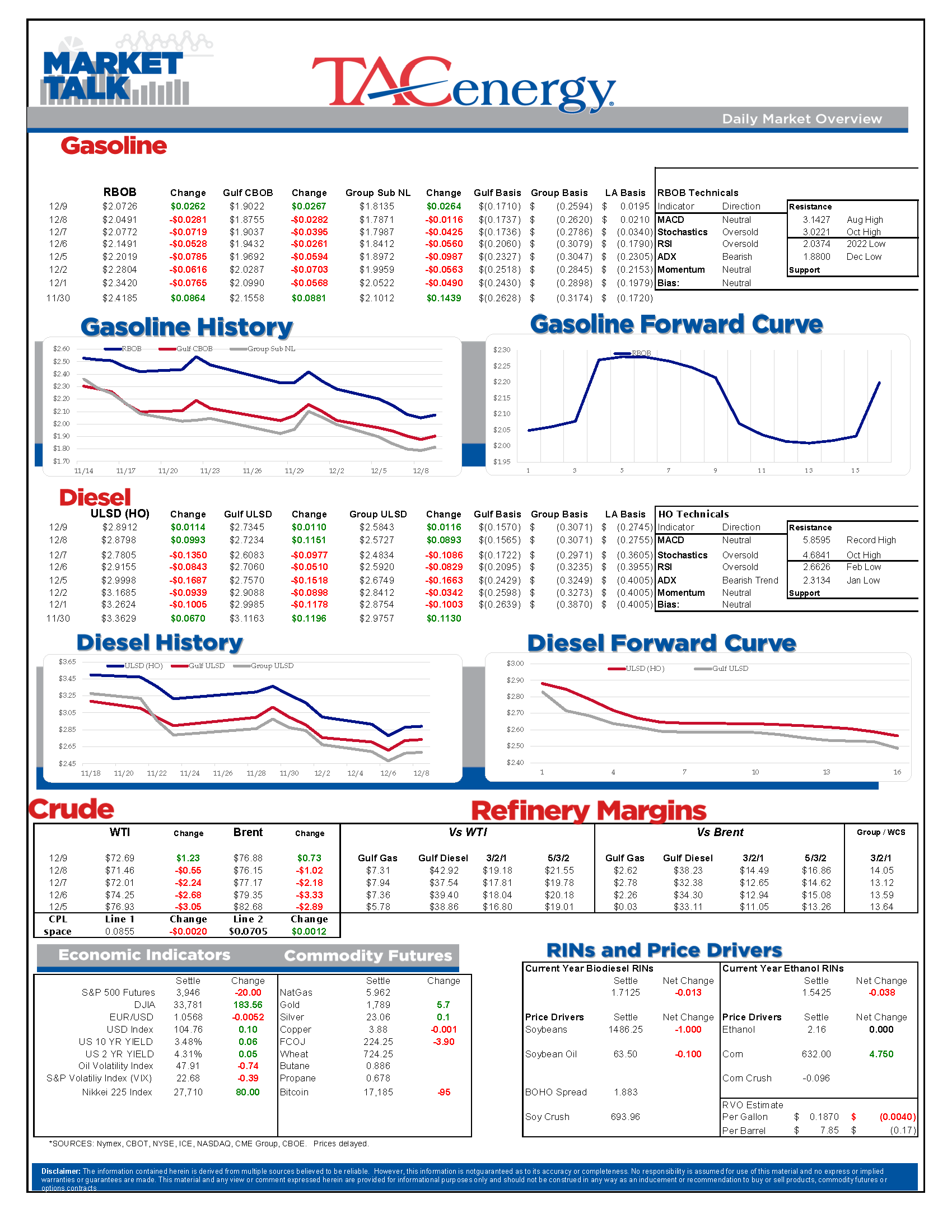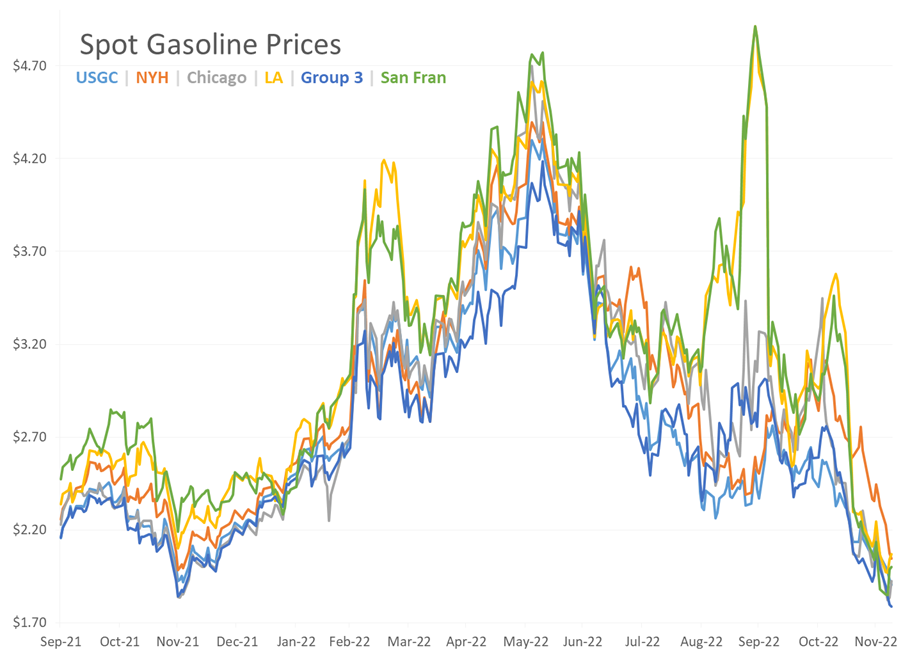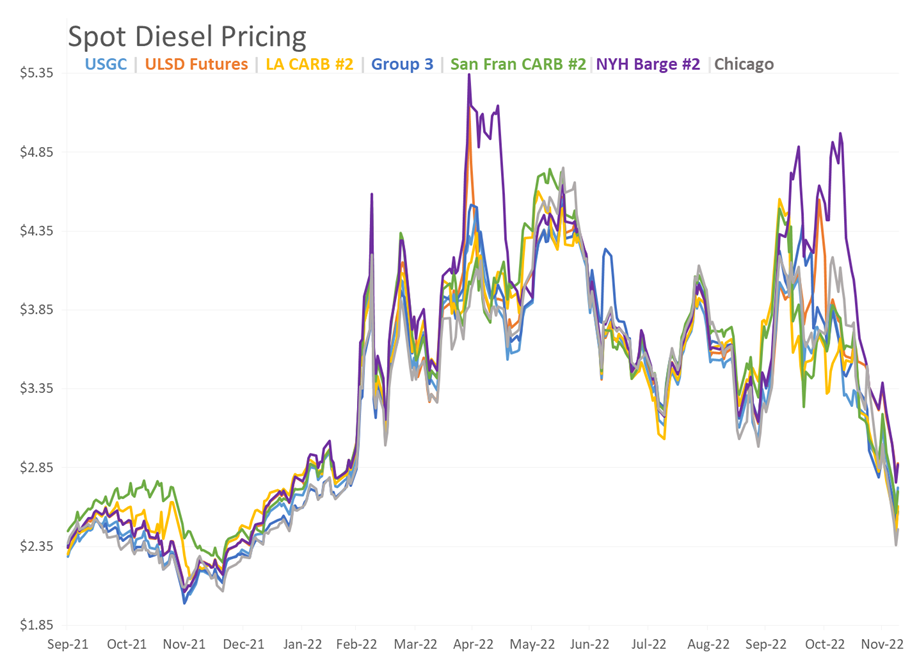Energy Futures Are Seeing Modest Gains To Start Friday’s Session

Energy futures are seeing modest gains to start Friday’s session, limping towards the finish line of a week that’s pushed prices to their lowest levels of the year, and cut 20-30 cents off of refined products.
WTI futures have had a fairly muted reaction to news that the Keystone pipeline was forced to shut after more than ½ million gallons reportedly spilled into a Kansas creek this week. A timeline for restart is still unclear, but so far the price action suggests refiners aren’t panicking about where they’ll find replacement barrels, and those north of the spill may be rewarded with discounted barrels that now find themselves stranded, such as Western Canadian Select which is now trading down to $50/barrel.
If RBOB can finish in the green today, it would mark the first trading day so far in December where the gasoline contract didn’t end lower, after 6 straight losing sessions. Cash markets are also looking weak, as the spread between gasoline prices in New York and the Gulf Coast dropped to its lowest level since early October this week, putting downward pressure on the price to lease space on Colonial’s Line 1. With refiners running full out to capture huge diesel margins, gasoline is becoming an unwelcome byproduct in many markets, and could become oversupplied in some regions in the near future, which could force some plants to reduce run rates.
Distillate prices are seeing a similar convergence with the spread between Gulf and East coasts now less than 30 cents/gallon, which is more than $1/gallon lower than it was a month ago. Softer demand for both products due to the seasonal slowdown in gasoline and unseasonably warm weather limiting Heating Oil consumption are both getting credit for these cash markets suddenly returning to something more closely resembling what we’re used to seeing.
Bad news is good news for stock markets as any negative data points may give the FED reason to slow their interest rate hikes. Yesterday we saw stocks rally after an increase in jobless claims in the US. Today we’re seeing stocks give back some of yesterday’s gains after the PPI report showed inflation is remaining stubbornly high and above many forecasts, giving the FED another reason to continue with its tightening. Energy contracts continue to have a weak correlation to daily moves in equity prices, so it’s not too surprising we are seeing a small rally today even though stocks are pulling back.
Chinese refiners are racing to take advantage of liberal quotas this year and are expected to reach a record level of refined fuel exports this month. Those supplies have provided a much needed supplement for a world short on distillates, but there are many questions and few answers about what they’ll look like next year.
Click here to download a PDF of today's TACenergy Market Talk.
Latest Posts
Week 15 - US DOE Inventory Recap
Prices To Lease Space On Colonial’s Main Gasoline Line Continue To Rally This Week
Equity Markets Have Been Pulling Back Sharply In Recent Days As Inflation And Trade Concerns Inject A Sense Of Reality Into Stocks
Gasoline And Crude Oil Prices Reached Fresh Multi-Month Highs Friday Morning As News Of The Anticipated Attacks Spread
Social Media
News & Views
View All
Week 15 - US DOE Inventory Recap

Prices To Lease Space On Colonial’s Main Gasoline Line Continue To Rally This Week
Energy markets are sliding lower again to start Wednesday’s trading as demand concerns and weaker stock markets around the world seem to be outweighing any supply concerns for the time being.
Rumors continue to swirl about an “imminent” response by Israel to Iran’s attacks, but so far, no news seems to be taken as good news in the hopes that further escalation can be avoided, even as tensions near the Red Sea and Strait of Hormuz continue to simmer.
Prices to lease space on Colonial’s main gasoline line continue to rally this week, trading north of 11 cents/gallon as Gulf Coast producers still struggle to find outlets for their production, despite a healthy export market. Gulf Coast CBOB is trading at discounts of around 34 cents to futures, while Gulf Coast RBOB is trading around a 16-cent discount, which gives shippers room to pay up for the linespace and still deliver into the East Coast markets at a profit.
Back to reality, or just the start of more volatility? California CARBOB basis values have dropped back to “only” 40 cent premiums to RBOB futures this week, as multiple flaring events at California refineries don’t appear to have impacted supply. The state has been an island for fuel supplies for many years as its boutique grades prevent imports from neighboring states, and now add the conversion of the P66 Rodeo refinery to renewable diesel production and the pending changes to try and cap refinery profits, and it’s easier to understand why these markets are increasingly vulnerable to supply shocks and price spikes on gasoline.
RIN prices continue to fall this week, touching 44 cents/RIN for D4 and D6 values Tuesday, their lowest level in 6 weeks and just about a nickel above a 4-year low. While the sharp drop in RIN and LCFS values has caused several biodiesel and Renewable Diesel producers to either shut down or limit production, the growth in RIN generation continues thanks to projects like the Rodeo refinery conversion, making the supply in RINs still outpace the demand set by the Renewable Fuel Standard by a wide margin.
The API reported draws in refined products, 2.5 million barrels for gasoline and 427,000 barrels for distillates, while crude oil stocks had an estimated build of more than 4 million barrels. The DOE’s weekly report is due out at its normal time this morning.
Click here to download a PDF of today's TACenergy Market Talk.

Equity Markets Have Been Pulling Back Sharply In Recent Days As Inflation And Trade Concerns Inject A Sense Of Reality Into Stocks
It’s a mixed bag for energy markets to start Tuesday’s session with gasoline prices holding small gains, while oil and diesel prices show small losses as the world anxiously debates what comes next in the conflict, we’re still hoping we don’t have to call a war in the Middle East.
An early sell-off picked up steam Monday morning with refined products down more than a nickel for a few minutes, before reports that Israel was vowing to respond to Iran’s attack seemed to encourage buyers step back in an erase most of the losses for the day.
Equity markets have been pulling back sharply in recent days as inflation and trade concerns inject a sense of reality into stocks that had been flying high earlier in the year. The correlation between gasoline and crude oil prices had been fairly strong for the past couple of months but has since weakened as the weakness in stocks hasn’t yet trickled over into the energy arena. Both asset classes are seeing a tick higher in their volatility (aka Fear) indices this week however, and when fear starts driving the trade, we often see these prices move together.
Diesel has been underperforming the rest of the energy complex for most of the year so far, and those hoping for lower diesel prices got more good news when the Dangote refinery in Nigeria began loading diesel for domestic use Monday, in the latest milestone for the giant project that will have a major influence on Atlantic basin supply. Naturally, local lawmakers are already complaining that the refinery’s prices are too high.
The EIA this morning highlighted the record amount of crude oil China imported in 2023 after reopening the country post-COVID and after completing numerous new refinery builds in the past few years. Russia accounted for the largest increase in shipments to China last year, as China is one of the few countries that doesn’t mind ignoring sanctions. Speaking of which, the US House is expected to take up a new vote this week on sanctioning Chinese imports of Iranian crude, which the EIA notes are often hidden by relabeling the crude to make it appear as if it originated in Malaysia, Oman or the UAE.
We’re just 2 weeks away from the startup of Canada’s long-awaited Transmountain pipeline expansion that will bring roughly 600,000 barrels/day of capacity to the Pacific basin. That new outlet is great news for Canadian producers long restricted by takeaway capacity, and bad news for Midcontinent refiners who have grown accustomed to the discounted Canadian grades. A Bloomberg article Monday noted that Iraq’s Basrah Heavy crude is most likely to be displaced by West Coast US refiners who can now buy much closer to home.
Click here to download a PDF of today's TACenergy Market Talk.




